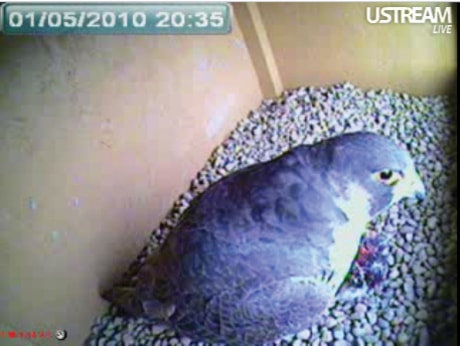And so it begins. At least it will in a few weeks, but we’re gearing up for the show.
Hopefully, the birds will co-operate. You may have heard already that the peregrine falcon webcam will be going back up again at the beginning of April.
And it will be bigger and better. We are putting in four cameras this year, as opposed to only one last year.
I know there were quite a few people who were frustrated because we couldn’t see what was happening on the ledge just outside of the nest box; therefore, we’re putting a camera to cover that angle.
But, I suppose I should back up a step and give a bit of history for the people who weren’t aware of the webcam last year.
The peregrine falcons have been nesting in a box on top of the Telus radio tower in the middle of Red Deer for the past 10 years or so.
Last year two Telus employees kindly went up the tower, lowered the old box down and put up a new box that had been supplied by Alberta Fish and Wildlife. The Red Deer River Naturalists had provided the camera and all the various techno stuff that allowed us to live- stream the events in the box to the world. It became an extremely popular site.
At the end of the season, Telus brought the box back down again so that we could make the changes to the camera system.
Besides the camera that was there last year and the one on the ledge that I’ve already mentioned, we will have a second camera that will be considered a back-up camera, just in case something fails but it will also perhaps provide us with the opportunity to view the birds in 3-D.
I am not a technologically savvy person so please do not ask me how that is going to work. It’s still being experimented with and our ‘tech guy’ tells me it should work, so keep your fingers crossed.
As well, we will have a night-vision camera in there. I’m told that it’s not really called “night-vision” and I was told I should use the proper technological jargon; it’s called “near infrared.”
But essentially it will let us watch the birds after it gets too dark for the other cameras to let us see. This camera will show in colour during the day and in black and white at night.
So, why do we need a night camera for birds who are not nocturnal, you may ask? Well, last year, during the night, two of the five eggs went missing and no one is sure what exactly happened. With 24-hour-seven-day-a-week viewing opportunities, we won’t have any questions like that.
So now all we need are the birds to come back and to decide that they still want to nest in that nest box; then we’re good to go.
I was asked if I thought the same birds would come back to this nest. My answer to that was, “Maybe . . . maybe not.” I’m not sure about the male, but I do know that the female nesting in the box last year was not the same female as the one nesting there in 2009. So, who knows who it might be in the box in 2011.
It would appear that there are a lot of people out there who surf the net looking for bird nest cams. They go from bald eagles in Decorah, Iowa, to hummingbird nests in Orange County, Calif.
There seems to be no end of sites that you can go to. You may also be aware that the great horned owl nesting at Ellis Bird Farm is now on the web, too. A webcam was installed beside her nest and people have been enjoying that site.
We’ve had everything from porcupines curled up in the nest while the female was away, to snow up to mom’s eyeballs during the past little while. It was fascinating to watch her slowly get covered with snow; then she’d move to shake the snow off her back and then stay still again for the longest time. Good thing she has a lot of feathery insulation to keep her warm.
So, until the peregrine webcam goes on line, view some or all of the other webcams. Just enjoy the birds.
Judy Boyd is a naturalist with the Red Deer River Naturalists.
